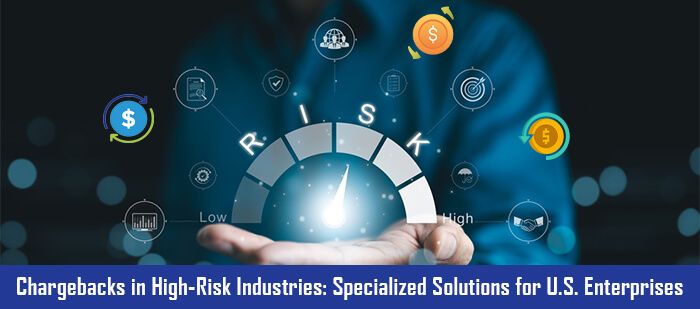
Chargebacks are a significant concern for U.S. enterprises operating in high-risk industries, where the potential for fraud and disputes can lead to substantial financial losses. Managing chargebacks in high-risk sectors requires a specialized approach, as traditional strategies often fall short. Businesses in areas such as e-commerce, travel, and adult services face unique challenges, including increased scrutiny from payment processors and higher fees. Understanding the underlying reasons for chargebacks and implementing targeted solutions is essential for maintaining profitability and a positive reputation.
By leveraging advanced analytics and tailored risk management strategies, companies can reduce the frequency of chargebacks and foster better relationships with payment providers. This blog post will explore effective techniques and best practices for mitigating chargeback risks, ensuring that U.S. high-risk businesses can thrive in a competitive marketplace while safeguarding their revenue.
Understanding Chargebacks in High-Risk Industries
In high-risk industries, chargebacks occur when customers dispute a transaction, leading to the reversal of funds. This process can be initiated for various reasons, such as fraudulent activity, customer dissatisfaction, or processing errors. High-risk sectors like e-commerce, travel, and adult services are particularly vulnerable due to the nature of their products and services, which often involve higher transaction volumes and more significant risk of fraud.
Payment processors categorize these businesses as high-risk, subjecting them to stringent scrutiny and higher fees. This increased oversight can result in more frequent chargeback occurrences, complicating financial management and operational efficiency. Businesses must understand the nuances of chargeback codes and the specific reasons behind disputes to effectively address and prevent them.
By doing so, they can identify patterns and implement corrective measures to minimize future occurrences. Recognizing the common triggers and implementing robust verification processes can help high-risk businesses mitigate the negative impact of chargebacks, ensuring smoother transactions and better customer relationships.
Some Related Blogs
- Reducing Chargebacks for U.S. Subscription-Based Services
- Navigating Chargeback Fees: Essential Information for U.S. Enterprises
- Proven Chargeback Representment Techniques for U.S. Businesses
- How to Establish a Strong Chargeback Prevention Strategy for U.S. E-Commerce Firms
Common Causes of Chargebacks in High-Risk Sectors
Chargebacks in high-risk sectors can stem from a variety of sources, with fraudulent transactions being a significant cause. Cybercriminals often target businesses with high transaction volumes, exploiting vulnerabilities in payment systems. Customer dissatisfaction also plays a major role, particularly in industries like travel and adult services, where service quality and delivery can be highly subjective.
Processing errors, such as incorrect billing or double charges, further contribute to the problem. Additionally, high-risk businesses often face increased scrutiny from payment processors, which can result in more disputes being flagged and reversed.
Poor communication or unclear return policies can also lead to misunderstandings and subsequent chargebacks. In some cases, friendly fraud—where a customer disputes a legitimate transaction—can occur, driven by buyer’s remorse or attempts to obtain free products or services. Understanding these common causes helps high-risk businesses implement targeted measures to reduce chargebacks and protect their revenue streams.
Impact of Chargebacks on U.S. High-Risk Businesses
Chargebacks can significantly impact U.S. high-risk businesses by straining their financial resources and damaging their reputations. When chargebacks occur, businesses not only lose the revenue from the disputed transactions but also incur additional costs such as chargeback fees and increased operational expenses to manage disputes. Frequent chargebacks can lead to higher processing fees, as payment processors view these businesses as riskier clients. Over time, this can erode profit margins and make it difficult for businesses to maintain financial stability.
![]()
Email us anytime!
Email customer service 24/7
![]()
Call us anytime!
Reach customer care 24/7 at +1 (888) 901-8653
Moreover, a high rate of chargebacks can result in stricter terms from payment processors or even the termination of merchant accounts, making it challenging for high-risk businesses to accept payments. This disruption in payment processing capabilities can severely hamper operations and customer satisfaction. Additionally, recurring chargebacks can damage a company’s reputation, leading to loss of customer trust and potential decline in sales.
The operational burden of handling chargebacks is also significant, requiring dedicated resources to investigate disputes, communicate with payment processors, and implement corrective measures. This diverts focus from core business activities and can negatively affect overall efficiency and productivity. Understanding and mitigating the impact of chargebacks is crucial for high-risk businesses to sustain growth and profitability in a competitive environment.
Strategies for Managing Chargebacks in High-Risk Sectors
Implementing effective strategies is crucial for managing chargebacks in high-risk sectors. Start by optimizing fraud detection systems to identify and block suspicious transactions in real-time. Using advanced analytics and machine learning algorithms can help detect unusual patterns that may indicate fraudulent activity. Clear and transparent communication with customers is also essential; ensure that all policies regarding returns, refunds, and billing are easily accessible and well-defined. This minimizes misunderstandings that can lead to disputes.
Invest in comprehensive employee training programs focused on fraud prevention and customer service. Well-trained staff can identify potential red flags and handle transactions more accurately, reducing the likelihood of processing errors. Incorporating robust verification processes, such as two-factor authentication, can further safeguard against fraudulent transactions.
Another key strategy involves maintaining detailed transaction records and documentation. Having readily available evidence can facilitate quicker resolution of disputes and strengthen your case when challenging illegitimate chargebacks.
Finally, collaborate closely with your payment processors to stay informed about best practices and industry standards. Regularly review and update your chargeback management protocols to adapt to evolving threats and regulatory changes. By combining these strategies, high-risk businesses can better manage chargebacks and protect their financial health.


